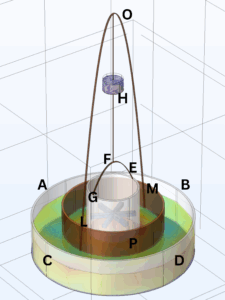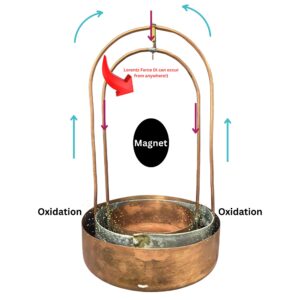Ryan Yu | 7/14/25
After conducting a literature search by translating & analyzing Ampere’s description of the device and then constructing it, I felt confident recreating it in COMSOL for the purpose of gauging how it could be improved. In the COMSOL geometry, the curved arches, LOM & EFG, are created with extruded parametric curves, while the thin walls of the vessel are formed with an extruded workplane. The magnet is suspended in the simulation space without the apparatus Ampere describes.
ABCD: Zinc Vessel, with an cylindrical opening in the middle
EFG: Inner arch that supports a vertical copper rod, FH
H: A capful of mercury
LOM: The outer arch that is connected (soldered, in the physical experiment) to the suspended copper ring LMP
Sulfuric Acid, which can conduct electricity, fills the basin (colored green for visibility)


The copper ring, connected to the movable conductor, forms part of a closed electrical circuit that is powered by a voltaic cell with sulfuric acid. When current flows through the ungrounded conductor and a magnetic field is applied by the permanent magnet, the conductor experiences a force called the Lorentz Force due to the interaction of the magnetic field and the electric current that generates torque. The experiment confirms that electric current can generate mechanical motion through magnetic interactions. The Rotating Conductors laid the foundation for the development of electrodynamics and the invention of electric motors.
 —-How rotation is generated
—-How rotation is generated
In COMSOL, to visualize the rotating conductor from Lorentz Force, there is a coupling between the magnetic fields and rotating domain interfaces, as well as an ODE to integrate the surface of the rotating conductor and the Lorentz force enacted upon it. This is stored as variable torque_z. The prescribed rotation of the conductor under the rotating domain module is defined as torque_z/I, as angular velocity=torque/inertia, calculated and updated every .1 seconds.
This simulation succeeded in the sense that COMSOL solved and derived a torque from the interplay of the different systems.
However, the geometry was meshed as “extremely coarse”, both because of the fine differences between the interactions of the arches and cylinder surfaces, and to expedite the computation time. (COMSOL required three hours to resolve for the “extremely coarse” mesh) This renders the software inefficient for accurately measuring angular velocity over time. A different approach is needed.
The simulation confirms Ampere’s original premise: a current-carrying conductor within a strong magnetic field experiences a mechanical Lorentz force that causes rotation.
My question shifts to how the placement of two magnets can alter the speed of rotation. Click here to see more.